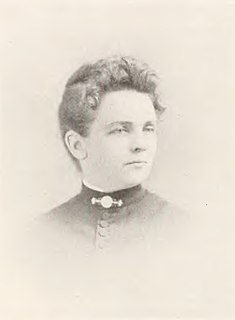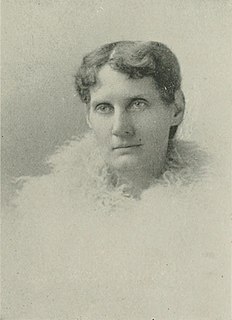
Harriet Goodhue Hosmer was a neoclassical sculptor, considered the most distinguished female sculptor in America during the 19th century. She is known as the first female professional sculptor. Among other technical innovations, she pioneered a process for turning limestone into marble. Hosmer once lived in an expatriate colony in Rome, befriending many prominent writers and artists.

Kate Sanborn was an American author, teacher and lecturer. Also a reviewer, compiler, essayist, and farmer, Sanborn was famous for her cooking and housekeeping.

The Brown School at Washington University in St. Louis is a school for the training of social science researchers. The Brown School offers a Master of Social Work (MSW), a Master of Public Health (MPH), a Master of Social Policy, a PhD in Social Work, and a PhD in Public Health Sciences. The social work school and public health programs are top-ranked by US News. As one of the academic units of Washington University in St. Louis, the Brown School was founded in 1925 as the department of social work. The school was endowed in 1945 by Bettie Bofinger Brown and named for her husband, George Warren Brown, a St. Louis philanthropist and co-founder of the Brown Shoe Company. The school was the first in the country to have a building for the purpose of social work education, and it is also a founding member of the Association of Schools and Programs of Public Health. The school is housed within Brown, Goldfarb, and Hillman Halls.

The University of Missouri–St. Louis (UMSL) is a public research university in St. Louis, Missouri. Established in 1963, it is one of four universities in the University of Missouri System and its newest. UMSL's campus is located on the former grounds of the Bellerive Country Club in St. Louis County, with an address in St. Louis city. The campus stretches into the municipalities of Bellerive, Bel-Nor and Normandy. Additional facilities are located at the former site of Marillac College and at Grand Center, both in St. Louis city.

Anita Calvert Lebourgeois was an attorney, judge, genealogist, biographer and women's suffrage orator. At the time, she was the only woman genealogist, or historian of ancestry, in Minnesota.

Genevieve Stebbins was an American author, teacher of her system of Harmonic Gymnastics and performer of the Delsarte system of expression. She published four books and was the founder of the New York School of Expression.

Julia Schoenfeld was a Jewish-American social worker, writer, and activist. During the period of her settlement work, Schoenfeld became interested in recreation for working girls, a subject on which she became a recognized authority. Her investigation of public dance halls in New York City, undertaken in 1908 while she was secretary of the Committee on the Amusement Resources of Working Girls, was the basis for the model New York City ordinance regulating dance halls. Later, as secretary of the Playground and Recreation Association of America, she conducted dance hall investigations in Boston, Massachusetts, St. Joseph, Missouri, Johnstown, Pennsylvania, and Pittsburgh, Pennsylvania.

Annie Coolidge Rust (?–?) was a 19th-century American educator from the U.S. state of Virginia. A proponent of the Froebelian method, she focused on kindergarten training schools, playground courses, and a mother's course. She is remembered for Miss Annie Coolidge Rust's Froebel School of Kindergarten Normal Classes. She is remembered as the founder of the Miss Annie Coolidge Rust's Froebel School of Kindergarten Normal Classes.

Mary Dana Hicks was an American art educator from the U.S. state of New York.

Rebecca Ann Naylor Hazard was a 19th-century American philanthropist, suffragist, reformer, and writer from the U.S. state of Ohio. With a few other women, she formed the Woman Suffrage Association of Missouri and an Industrial Home for Girls in St. Louis. She organized a society known as the Freedmen's Aid Society, and served as president of the American Woman Suffrage Association.

Elizabeth Marney Conner was a 19th-century American dramatic reader and educator, and the founder of the Buffalo School of Elocution. She published recitations in both prose and verse, and was also the author of an operetta.

Amabel Anderson Arnold LL.M. was an American lawyer and law professor who organized the Woman's State Bar Association of Missouri, the first association of women lawyers in the world.

Adeline Palmier Wagoner was an American volunteer organizational leader and author. She served as president of the St. Louis, Missouri, branch of the National Plant, Flower and Fruit Guild, a charity for the poor and afflicted, and as president of the Shakespeare Tercentenary Society.

Annie Berenice Crumb Wyer was a St. Louis, Missouri, pianist, composer, and lecturer. Wyer composed for both piano and organ, and wrote art song and works for violin. She collaborated with Ethan Allen Taussig in performances of spoken recitation accompanied by the piano.

Cora Louise Boehringer was the first female superintendent of schools in Yuma County, Arizona. She has been called "the mother of the Arizona educational system". In 2008 she was inducted into the Arizona Women's Hall of Fame.

M. Louise Thomas was the founder of Lenox Hall, a girls' school in St. Louis.

Lucy M. Hall-Brown was an American physician and writer. She was a general practitioner and keen on education.

Elizabeth "Bessie" Morse founded the Morse School of Expression in 1907.

Louise McNair (1869-1956) was a mathematics teacher and the headmistress of Hosmer Hall for girls in St Louis.

Lily C. Whitaker was an American educator and author. She contributed to the Southern Quarterly, under her father's direction. She wrote for the New Orleans press, and was the author of Donata and Other Poems. Whitaker was elected president of the New Orleans Educational Association, and served as principal of one of the largest public schools in that city. She founded the first school of speech and oratory in the Southern United States.





















